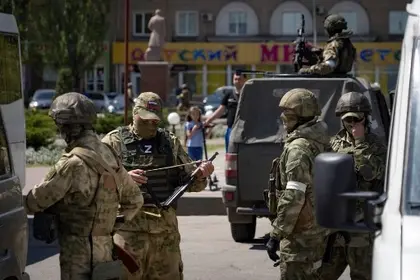According to the Institute for the Study of War (ISW), Ukrainian partisans have carried out dozens of confirmed attacks across occupied Ukraine and killed at least 11 Russian occupying officials and known collaborators.
The local population has been a key source of information about the number and movement of Russian troops, General Vadym Skibitsky told Kyiv Post in an exclusive interview.
JOIN US ON TELEGRAM
Follow our coverage of the war on the @Kyivpost_official.
“Since the beginning of the full-scale Russian invasion, [Ukrainian] intelligence has received a flurry of data from the local population… Even U.S. generals, with whom we cooperate, are surprised by such a unique situation whereby the local population provides detailed information about the enemy forces,” said Skibitsky.
- See the latest war in ukraine update in the Kyiv Post’s news bulletins released today.
- Check out the freshest Ukraine news items as of today.
The partisan movement and cooperation of the local population give the Ukrainian Armed Forces (UAF) a unique advantage over the enemy. Russians have expended significant resources defending captured territories, but traitors and Russian collaborators are being eliminated in successive assassination attempts organized by local resistance forces.
The invaders, therefore, do not feel at ease in the occupied territories.
Partisan groups who actively oppose the Russian invaders, are now operating across swathes of occupied territory, especially in the south. Among them are military trained individuals and ordinary citizens working hand in hand. Collectively, they help the UAF by providing reliable and timely information about military depots and concentrations of Russian troops.

British Defence Intelligence Update Ukraine 13 January 2025
The partisans themselves are focused on sabotage and removal of collaborators. The scale of the Ukrainian resistance movement has reached such a level that Russians now have severe problems attempting to establish control.
As a result of effective attacks by Ukrainian partisans, the Kremlin has been forced to spend resources on security at the rear instead of operations on the front line. This reduces Russia’s ability to defend itself against ongoing Ukrainian counteroffensives, not to mention resource the occupiers’ own offensive operations, according to the ISW.
Successful partisan operations
The partisans have two main tasks: surveillance and collection of reliable data on the direction of the Russian occupiers, including the location of their warehouses and barracks; and the destruction of collaborators
On Nov. 1, the ISW published an interactive map and detailed analysis of reliably confirmed Ukrainian partisans’ attacks since the beginning of the invasion.
On July 27, General Hryhoriy Halahan, former head of special operation forces (SSO), said in an interview with Radio Svoboda that Ukrainian SSO forces helped to coordinate local partisans in efforts to destroy the Russian military and collaborators in the occupied territories.
Thanks to the efficiency of partisans’ work, the UAF managed to strike precise blows on concentrations of Russians and their equipment in the Sumy and Kyiv regions.
In April, Ukrainian intelligence reported details of a partisan with the call sign “Wolf” – a local hunter who made forays into the forest and reconnoitered enemy positions. Thanks to “Wolf,” they managed to destroy 12 Russians with armored vehicles.
On July 11, partisans, working alongside the UAF, destroyed a warehouse in Nova Kakhovka containing Russian weapons and ammunition. Over the past two months, dozens of further explosions have since been recorded in the occupied territories, killing or injuring local collaborators.
Melitopol is considered the unofficial center of the Ukrainian partisan movement. Indeed, the ISW marks the Melitopol district on its maps as an area where Russian troops do not have full control over the territory due to its active partisan movement.
A notable act of the resistance movement in Melitopol was the blowing up of a railway bridge near the village of Yakymivka on April 28. Russian forces had hitherto used the bridge to supply military equipment and ammunition from the Crimean Peninsula to mainland Ukraine.
According to the Ukrainian General Staff in the wake of the attack, the bridge’s destruction was the result of the work of the SSO and organized partisan groups.
Destruction of logistics infrastructure in Melitopol is a regular occurrence: partisans blew up an armored train carrying occupiers and have already deployed several sabotage attacks on the railway.
Since May, the partisan movement has intensified elsewhere, including in the Zaporizhzhia region. Additionally, the partisan’s movement has also started its work in Crimea, which the Russians turned into a military base from which to attack mainland Ukraine.
Head of Zaporizhzhia Regional Military Administration Oleksandr Starukh stated on Ukrainian TV back in June that the occupiers regularly try to intimidate the partisans with death penalty threats, but that does not stop them. “Ukrainian partisans will continue to resist,” Starukh asserted.
Partisans in the Kherson region are actively carrying out information attacks on Russians and those who agree to cooperate with them. They have also been distributing leaflets with promises of rewards for the heads of the main collaborators. These include a reward of around $10,000 (equivalent) for the deputy head of the occupying administration of the Kherson region, Kyrylo Stremousov, and a similar reward for Russian collaborator Yevhen Balytskyi, the “mayor” of Melitopol.
In early August, even in the Luhansk region where pro-Russian support has historically been the largest, partisans have been making an impact.
“Partisans have started working in our region and they are quite successful, not only posting leaflets but destroying infrastructure facilities. This helps to slow down the attacks and advance of the Russian army,” said Governor of Luhansk region Serhiy Haidai.
According to Haidai, in September, the Luhansk region’s distribution network for railway tracks was destroyed. This stopped the rail logistics networks of the Russian army for some time. In August in occupied Bilovodsk, Luhasnk, partisans shot at a car carrying the “mayor” and his “deputy.”
You can also highlight the text and press Ctrl + Enter










